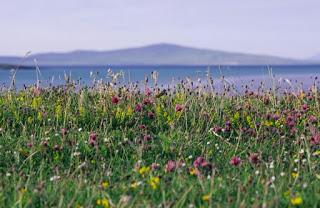
© SNH-Lorne Gill
One of Europe’s rarest habitats has been mapped for the first time in Scotland by Scottish Natural Heritage (SNH). Scotland and Ireland are the only two countries in the world that have the unique shell-rich dune grassland called machair, the majority being in Scotland.SNH is leading a multi-partner project to produce a comprehensive Habitat Map of Scotland (HabMoS) by 2019 and machair is one of 50 important habitats to receive attention. The project is a major contribution to the Scottish Government’s 2020 Challenge for Biodiversity and, together with the UK SeaMap, will in time provide a complete picture of all of Scotland’s habitats.With the new machair map we now know that there are more than 13,000 hectares of this special habitat on our coasts, mainly in the Outer Hebrides, Tiree and Coll, with smaller amounts in the Northern Isles and the west coast mainland.Machair is a valuable part of our landscape in the Highlands and Islands, both because of the nature it is home to and for cultural reasons. Machair is known around the world and attracts visitors from far and wide who come to see it in all its glory.The habitat is so rare because it requires a specific combination of features, including low-lying coastline, sand enriched with calcareous shell fragments, strong winds to blow the sand inland and just the right amount of rainfall.However, most crucially, machair needs the influence of people and grazing animals, and it is found where strong on-shore winds drive sand inland from the beach and dunes, and where the climate has long been suitable only for small-scale agriculture.Machairs are suited to traditional crofting practices and for more than a thousand years have been managed using seasonal grazing, rotational cultivation without herbicides and using only natural fertilisers such as seaweed.Machair is notable for its rich diversity of wild flowers and other plant species, including several uncommon orchids. This richness of plants encourages a wide variety of invertebrates, which in turn attracts birds to feed and breed. Machair grasslands, for example, are the most important UK habitat for rare species such as corncrake and corn bunting.Professor Stewart Angus, SNH coastal ecologist, said: “Machair can be so spectacular in summer, with swathes of coloured wild flowers that change as the season progresses. On a warm summer day, with a vivid blue sea and dazzling beach sand, some of us feel there are few better places to be.“Machair is a constantly changing habitat, so the map represents a ‘snapshot’ in time. Accepting such limitations, this map is an invaluable aid to the assessment of change on our coasts, with a time-stamped baseline of machair distribution we can use to inform the impact of rising sea levels, as well as other impacts on a truly special feature of Scotland’s coastal environment.”Machair is a very low-lying habitat, especially vulnerable to the effects of climate change, and SNH is involved in a number of machair studies investigating the impacts of sea level rise.The map is available via the Habitat Map of Scotland web page (www.snh.gov.uk/about-scotlands-nathttp://www.snh.gov.uk/about-scotlands-nature/habitat-map-of-scotland/ure/habitat-map-of-scotland/).
